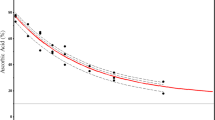Abstract
This paper is a companion article to the research originally presented in “Estimating Shelf Life through Tolerance Intervals” (Schwenke et al., 21:290, 2020) published in AAPS PharmSciTech where tolerance intervals are introduced as an alternative methodology for estimating pharmaceutical shelf life. An industry stability shelf life example data set was used to demonstrate the proposed methods. Although using industry data does give relevance to examples demonstrating shelf life estimation, measures of how well the proposed methods accurately and effectively estimate shelf life cannot be obtained because the true shelf life values are not known for example data sets. In this current paper, the results of a computer simulation are reported where the tolerance interval estimates of shelf life are compared to theoretically known true shelf life values. Various factors that affect a tolerance interval estimate of pharmaceutical shelf life are investigated. A critical decision factor is the choice of the proportion of the stability distribution allowed out of specification at expiry to define the pharmaceutical risk. The number of stability batches available for shelf life estimation and the storage time at which the estimate is made are also considered in this simulation study. The industry example data are again used as the basis for the simulation study to give relevance to this research.
Similar content being viewed by others
Abbreviations
- BBD:
-
Box-behnken Design
- BS:
-
Backscarttering
- CFU:
-
Colony-Forming unit
- CL_NP:
-
Cluser of nanoparticles
- Coated_LGG:
-
Coated Lacticaseibacillus rhamnous GG
- CPPs:
-
Critical process parameters
- CQAs:
-
Critical quality attributes
- CTRL:
-
Control
- DLS:
-
Dynamic light diffusion
- DoE:
-
Design of the experiment
- EDL:
-
Electric double layer
- LAB:
-
Lactic acid bacteria
- LGG:
-
Lacticaseibacillus rhamnous GG
- MCs:
-
Micricapsules
- NPs:
-
Nanoparticles
- PCs:
-
Photon correlation spectroscopy
- PDI:
-
Polydispersity index
- QTTP:
-
Quality target profile
- SD:
-
Standard deviation
- T:
-
Transmission
- TEM:
-
Transmission electron microscopy
- TSI:
-
Turbiscan Stability Index
- TSS:
-
Total soluble solids
- ZP:
-
Zeta potential
References
Schwenke J, Quinlan M, Stroup W, Forenzo P. Estimating shelf life through tolerance intervals. AAPS PharmSciTech. 2020;21:290. https://doi.org/10.1208/s12249-020-01800-2.
Capen R, Christopher D, Forenzo P, et al. On the shelf life of pharmaceutical products. AAPS PharmSciTech. 2012;13:911–8. https://doi.org/10.1208/s12249-012-9815-2.
Capen R, Christopher D, Forenzo P, et al. Evaluating current practices in shelf life estimation. AAPS PharmSciTech. 2018;19:668–80. https://doi.org/10.1208/s12249-017-0880-4.
Stroup W, Milliken G, Claassen E, Wolfinger R. SAS® for mixed models: introduction and basic applications. Cary, NC: SAS Institute Inc.; 2018.
SAS Institute Inc. SAS/STAT® 9.4 user’s guide. 2nd ed. Cary, NC: SAS Institute Inc.; 2012.
International Conference on Harmonisation of Technical Requirements for Registration of Pharmaceuticals for Human Use. Q1A(R2): stability testing of new drug substances and products. 2003.
International Conference on Harmonisation of Technical Requirements for Registration of Pharmaceuticals For Human Use. Q1E evaluation of stability data. 2004.
Acknowledgements
This work is a direct result of the authors’ discussions as cofounders and original members of the Product Quality Research Institute (PQRI) Stability Shelf Life Working Group which was established in 2006 and disbanded in late 2019. The authors wish to thank all past colleagues of the Working Group over the years and hope that the discussions in stability studies and shelf life estimation will continue.
Author information
Authors and Affiliations
Contributions
All authors contributed to the study conception and design. Material preparation, data collection, and analysis were performed by all authors. The first draft of the manuscript was written by James Schwenke, and all authors commented on previous versions of the manuscript. All authors read and approved the final manuscript.
Corresponding author
Ethics declarations
Competing Interests
The authors declare no competing interests.
Additional information
Publisher's Note
Springer Nature remains neutral with regard to jurisdictional claims in published maps and institutional affiliations.
Supplementary Information
Below is the link to the electronic supplementary material.
Rights and permissions
About this article
Cite this article
Schwenke, J., Forenzo, P., Stroup, W. et al. A Practical Discussion on Estimating Shelf Life Through Tolerance Intervals. AAPS PharmSciTech 22, 273 (2021). https://doi.org/10.1208/s12249-021-02119-2
Received:
Accepted:
Published:
DOI: https://doi.org/10.1208/s12249-021-02119-2




